Safeguarding medicines, poisonous products, and dangerous utensils and tools is a necessity in a house with children. You can keep these items se cure by installing a few inexpensive latches and locks on doors and cabinets.
Safety Latches: A variety of products for childproofing kitchen appliances are avail able at home-improvement centers, but with very young children, a simple homemade latch will keep the door of a refrigerator or other appliance closed (bottom). A cabinet door can be kept safely shut with a concealed latch.
The model opposite will foil youngsters but open at the touch of an adult’s finger.
Locks: A storage area some times may need a true lock to guard its contents. For sliding doors, a showcase lock —the kind used in jewelry stores—is easy to install; it simply clamps into place. Swinging doors can be fitted with a hasp and a locking cam (rather than a separate padlock) that are screwed to the outside of the doors. A recessed drawer lock can be installed with a minimum of time and effort.
TOOLS
- Screwdriver
- Tape measure
- Electric drill
- Spade bit
- Wood chisel
- Mallet
MATERIALS
- Showcase Lock
- Cabinet Latch
- Hasp Lock
- Drawer Lock
- Fabric fastening tape
- Double-sided foam adhesive tape
- Dark lipstick
SAFETY TIPS: Protect your eyes with goggles when using an electric drill.
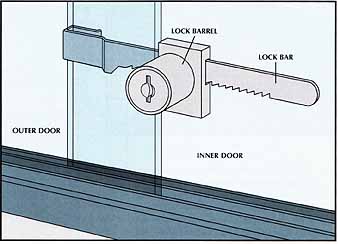
Attaching a showcase lock.
• With the doors open, slip the hook of the serrated Jock bar around the edge of the inner door.
• Close the doors and slide the lock barrel over the bar until the barrel is flush with the edge of the outside door. The Jock can not be removed, nor the doors opened, until you unlock the barrel with a key.
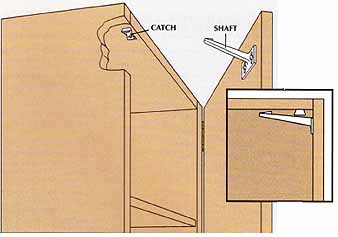
Childproofing a cabinet.
• Screw the catch inside the cabinet top no more than 1 inch from the front edge.
• Set the end of the latch shaft in the catch, swing the door onto the base of the shaft, and mark where the base meets the inside of the door.
• Fasten the base of the shaft to the door with screws. When the door is closed, the shaft will engage the catch (inset); to release it, open the door just wide enough to slip a finger over the shaft and push it down.
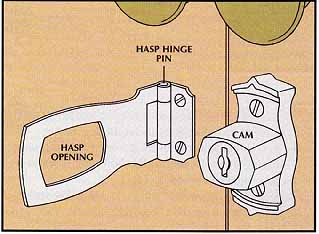
Installing a hasp lock.
• Measure the distance between the centers of the hasp hinge pin and the hasp opening, and mark the face of one cabinet door at a point that is one-half this distance from the edge of the door.
• Set the hasp against the door with its hinge pin centered over the mark.
• Mark the screw holes and attach the hasp to the door.
• Set the lock against the adjoining door and fold the hasp over the cam.
• Remove the hasp and mark the positions of the lock’s screw holes, then fasten the lock to the door. To secure the hasp to the lock, turn the cam 90 degrees; open it with the key.
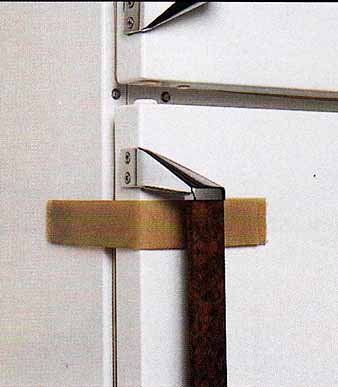
Trick of the Trade -- Securing an Appliance Door
A simple latch for an appliance door can be made from strips of fastening tape (commonly known by its trade name, Velcro) fixed to the door at a height beyond the reach of your child. With double-sided foam adhesive tape, fasten short strips of Velcro on the door and on the side of the appliance. Lay the fastening strip over them to keep the door secured.
A Recessed Drawer Lock
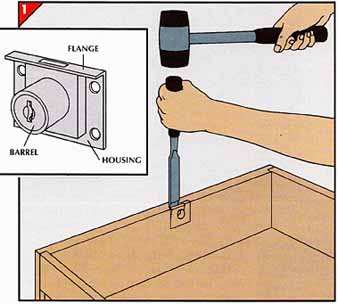
1. Cutting the mortises.
• Measure the distance from the top of the lock flange to the center of the barrel, and mark this distance down from the top of the drawer.
• At the mark, drill a hole with a spade bit the size of the barrel and insert the barrel from inside the drawer.
• Mark the length of the flange on the drawer top and cut the flange mortise.
• Reinsert the barrel, outline the housing, and cut the housing mortise.
• Screw the lock in place from inside the drawer.
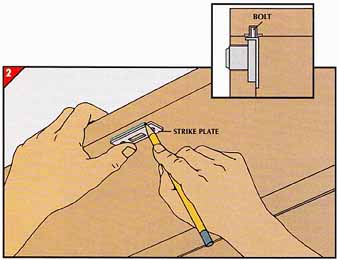
2. Mounting the strike plate.
• Rub dark lipstick on the top of the lock bolt, close the drawer fully, and use the key to extend the bolt until it presses against the cabinet top.
• Remove the drawer, position the strike plate hole over the lipstick mark, and trace the outline of the plate and the hole.
• Drill out as much wood as possible within the marks delineating the bolt hole—deep enough to seat the bolt fully (inset)—then chisel out the remainder.
• Cut the mortise for the strike plate, then screw the plate to the cabinet.
Previous: How
to Make Stairs Safer
Next: Adapting
a Home for the Handicapped